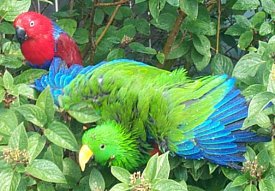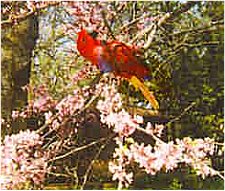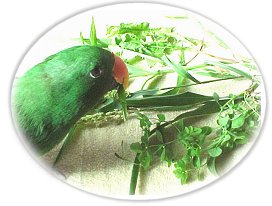

Some of the safe houseplants that we can grow for birds are asters, ferns, spider plants, geraniums, pansies, nasturtiums, marigolds, dandelions, and a real treat for parrots to eat, day lilies! Many parrots eat flowers in the wild and indeed, they are the main component of the diet of some avian species.
It is as essential to learn the difference between toxic and non-toxic varieties of trees and plants, and to use only untreated branches and plants that are free of chemicals and droppings from wild birds. Highly poisonous herbicides are used to eliminate weeds and plants bordering roadways so roadside trees and plants can be deadly fare.
Vitamin A deficiency compromises the immune system and eventually affects even the outward appearance of the parrot. Dull looking eyes and feathers are the most common visible symptom. The richest and most natural source of vitamin A is dark leafy greens. Dandelion greens, kale, beet tops, and other leafy greens contain the highest quality and most easily assimilated vitamin A. Vitamin K also is found in abundance in dark leafy greens and it is essential for blood clotting. All greens are low in calories, fat, and sodium. One cup of raw spinach contains only 14 calories. Greens are free of the fat and cholesterol that can cause obesity and its accompanying health problems in caged birds.
Birdkeepers must be creative in their presentation of a new food such as greens. Young birds are much more willing to try new foods than are older parrots. They have taste preferences just as humans do. Color, size and texture can be varied to pique their curiosity and encourage them to try green foods. The following tips can be helpful.
- Place whole green leaves near the food dish to get the bird’s attention.
- Weave leafy greens through the cage bars at beak level.
- Hang stems of broccoli from shish-ka-bob food holders.
- Use the monkey see — monkey do approach by allowing birds observe a teacher bird eating green foods.
- Mix chopped greens with another favorite food, such as cut corn.
- Wrap a tasty treat in a leaf of greens to capture the bird’s interest. Secure the leaf with a safe tie made of rawhide or short lengths of cotton cord.
- Mince leafy greens and bake them in birdie bread or cornbread.
- Repeatedly offer greens in a variety of tempting ways. One try is not enough.
PHYTONUTRIENTS
Greens contain phytochemicals which are substances found in plants that help to prevent cancer and heart disease, among other health problems. Fiber is important to the health of parrots and can be found in generous amounts in green foods. Fiber has many functions in the system including the regulation of glucose and cholesterol. Carotenes, including beta carotene, lutein, lycopene, and zeaxanthin are antioxidants that ward off many diseases and keep the eyes and mucus membranes healthy in parrots. In one study of humans who ate two servings a week of spinach or collard greens, they had half the risk of macular degeneration of the eye than did non-greens eaters. Vitamin A which is manufactured in the parrot’s body from carotenes protects the digestive, reproductive, and respiratory tracts. Darker greens have a higher beta carotene content than lighter greens so choose kale, collards, and other leafy greens of deep color.
Most birdkeepers are aware of the importance of calcium to the bone structure of parrots. It also assists in blood clotting, muscle contraction, nerve transmission, and egg formation and laying in females. Dark leafy greens are far richer in calcium per calorie than is cow’s milk. Kale, turnip greens, mustard greens, broccoli, and bok choy are the greens richest in calcium. The folic acid found in greens is an important B vitamin that helps to ward off heart disease by working with enzymes that dispose of homocysteine, a harmful blood chemical that irritates artery walls. Folic acid also aids in red-blood cell formation. Magnesium, also found in greens, is an essential mineral that controls many metabolic processes. It promotes absorption and metabolism of other minerals, particularly calcium and should be fed in relatively equal amounts to phosphorus. Magnesium is critical for a bird coping with stress. It is sometimes called the “stress relieving mineral”. Potassium in greens is important to blood pressure regulation, transmission of nerve impulses, and proper digestion. It helps the birds’ muscles to contract and it helps to regulate the heartbeat. Studies of cruciferous vegetables such as broccoli and cabbage have identified flucosinolates that speed up the detoxification process, helping to rid the body of potential damaging agents that would otherwise affect healthy cellular replication and potentially lead to uncontrolled cell growth and cancer.
Nowhere in nature are vitamins and minerals isolated, so supplements are not a natural way for parrots to get the nutrients that they need. To prevent vitamin A deficiency, which is the most common nutritional problem of birds, the following foods are extremely rich in beta-carotene, the precursor of vitamin A: broccoli leaves, dandelion leaves, spinach, turnip greens, and collard greens.
Here is a brief description of some popular green foods that are beneficial to the health of parrots. The darkest leaves are richest in nutrients.

- Arugula (pronounced ah-ROO-ga-la) is a peppery flavored, oak-shaped leaf with medium to dark-green color. The leaves are tender with a slightly bitter and peppery taste similar to radishes. Arugula is sold in small bunches which should be fresh and bright green. To store, wrap the roots in damp toweling within a plastic bag. Arugula is a good source of calcium, potassium, and copper.
- Barley grass can be grown by parrot owners as an easy source of fresh and nutritious greens. Barley greens contain good amounts of potassium and silicon, important to the health of skin and feathers. Medicinal benefits: A study published in the Journal of the Science of Food and Agriculture shows that young barley grass degrades a variety of pesticides. The study shows that, among others, malathion and diazinon are degraded by the presence of dilute barley grass. (The article can be found in Volume 79, Issue 10, 1999.) Unless parrots consume only organic produce, they also consume traces of pesticides. Fresh or barley grass concentrate is one of the few ways to detoxify pesticides. Barley is a good tonic and is useful for gout.
- Beet greens are dark green rough leaves with a red stalk and a cabbage flavor. Look for crisp, green or reddish-green leaves. For maximum nutritional value, buy beet greens with the beets still attached. Parrots will eat shredded beets as well as the greens, especially if combined with a favorite food such as corn. Beet greens contain potassium, magnesium, iodine and iron. They are a good source of calcium, fiber and the antioxidant vitamins A & C. Medicinal benefits: Useful as blood building agent and as a mineral supplement. Iodine content is valuable for parrots diagnosed with underactive thyroid.
- Belgian endive is a tight, elongated cluster of leaves of white to pale yellow-green color. It is a good source of potassium. Parrots enjoy peeling the individual thin leaves from the head of endive. Contains potassium, calcium and sulfur. Medicinal benefits: Use as a mineral supplement.
- Bok choy has a mild cabbage flavor. It grows in stalks resembling celery with green leaves. It is a member of the cruciferous vegetable family. Contains natural sodium, calcium, magnesium and iron. Medicinal benefits: Cruciferous vegetables offer protection against cancer.

- Chickweed is a small herbal plant that grows wild throughout the world. Care must be taken to harvest only pesticide-free plants. Medicinal benefits: Useful in the treatment of skin and blood disorders, gout, and arthritis.
- Chicory is a member of the sunflower family and is a bushy head of greens with narrow, twisted, frilly leaves that are dark green at the top fading to light green at the stem. It is bitter flavored and is sometimes referred to as curly endive. Chicory is a good source of calcium, potassium, vitamin A, high quality inulin, fructose sugar and other fructose-related carbohydrates known as fructooligosaccharides. Medicinal benefits: Chicory encourages the Bifidus group of bacteria in the intestinal tract of parrots, which helps to retard the growth of various pathogenic bacteria.
- Collard greens are large, wide, dark silvery-green leaves with a strong flavor. They taste like a cross between spinach and watercress. Collard greens are a form of kale and are one of the most nutritious of greens. Rich in fiber as well as vitamins A and C. Medicinal benefits: Beneficial to digestion. Excellent fiber content.
- Dandelion is a member of the sunflower family. The leaves have irregular and jagged edges and a yellow flower grows from the hollow stem in the center of the rosette of leaves. The leaves have a rich and slightly bitter flavor. They should be harvested only from pesticide free areas when the tender young leaves are less than six inches long. Recent research has shown the dandelion to be nature’s richest vegetable source of cancer-fighting beta-carotene. Dandelion greens are richer in potassium than bananas, and the flowers are richer in lecithin than soybeans. Dandelions contain many trace minerals. Commercial growing of dandelion greens is a ten million-dollar annual business so parrot owners should be able to find them in many stores. Many birds enjoy the yellow dandelion flowers as well as the greens. Both are excellent sources of vitamin A, calcium, and other nutrients. Medicinal benefits: Useful as a digestive stimulant and as a treatment for gout, skin problems, and liver disorders.
- Endive is a member of the chicory family. Curly endive has frilly leaves. Look for tightly furled heads of creamy white color. The leaves should be pale yellow at the tips. The center of the stem should “give” slightly to the touch. Endive is a bitter-flavored green and a member of the chicory family. Look for tightly furled heads with leaves that are pale yellow at the tips. Store in a paper bag and refrigerate in the vegetable drawer. Contains calcium, potassium and natural sulphur. Medicinal benefits: Useful as an appetite stimulant. Helps to rid the body of infection.
- Escarole is a broad-leafed cousin of curly endive. Look for crisp, green heads of broad, curly-edged leaves that are dark green at the top and pale at the stem with a slightly bitter and nutty flavor. Medicinal benefits: Bitter greens act as a tonic and the fiber is beneficial to digestion.
- Kale is one of the most nutritious greens. The most popular variety has ruffled leaves that are greenish-blue to dark green with a mild cabbage flavor. If picked young, it is tender. Older leaves are tougher with a stronger taste. Select fresh-looking kale and refrigerate it in a perforated plastic bag. Medicinal benefits: Excellent source of calcium for building strong bones and maintaining a healthy nervous system.
- Lettuces such as iceberg have little color and almost no nutrition. Romaine lettuce has more nutrition than other lettuce varieties and is enjoyed by most parrots. Lettuce does provide some fiber.
- Mustard greens are oval shaped with frilly edges. They have a sharp peppery taste. Young, tender leaves are relished by parrots, known for their love of “hot” foods. Contains sulphur, calcium, potassium and magnesium. Medicinal benefits: Good liver cleanser.
- Parsley is a particularly nutritious green plant but for whatever reason, it has long been suspected of being poisonous to birds. Parsley is not toxic to birds and can be fed in moderation without any problem. It is a good source of iron, beta carotene and vitamins B1, B2 and C. Parsley contains most of the amino acids that are the “building blocks” of protein. Medicinal benefits: Parsley is useful as a blood purifier. It detoxifies harmful contaminants, promotes healthy skin and feathers, tones the digestive system, prevents kidney ailments and treats arthritis. It also acts as a natural antibiotic.
- Radicchio pronounced (rah-deek-e-oh) has a mild and pleasantly bitter cabbage flavor. It is shaped like a small cabbage. Leaves turn from bright green to deep maroon as the plant matures.
- Rapini is also known as broccoli raab, or rapa and is a medium-sharp flavored green with edible stems and small bud clusters which turn yellow with age. Parrots are known to relish the buds of leaves and flowers in the wild so the buds of rapini are a good choice for parrots, although more costly than some greens. Medicinal benefits: cruciferous vegetable that protects against cancer.
- Romaine lettuce, also known as cos, is an elongated head of loosely packed broad leaves. The crisp leaves are dark green in color and romaine is considered the only lettuce with any nutritional value. The long leaves can be woven into cage bars to allow parrots to forage for their food. Contains trace amounts of calcium, sodium, and potassium.
- Spinach has oval-shaped, dark-green leaves with a slightly spicy taste. Spinach is the highest source of fiber, calcium and Vitamin A of the leafy greens, with minerals and vitamin C as well. An extremely nutritious food, it also is a good source of iron and potassium. Although it contains oxalates it can be fed in moderation without a problem. Medicinal benefits: Blood builder and beneficial to feather health. Contains lutein and zeaxanthin, which prevent damage to the eyes from sunlight and free radicals.
- Sprouts that have reached their peak can be placed in the sunlight to develop chlorophyll as indicated by the greening of the leaves. Sprouts are an important part of a varied diet for parrots.
- Sunflower greens can be grown by planting sunflower seeds outdoors, or with proper lighting, indoors. In seven days, they grow to a height of about six inches. With good light, they develop valuable chlorophyll as well as all the nutrients of sunflower sprouts. They are readily accepted by most parrots.
- Swiss chard is strong-flavored, with large glossy fan-shaped green leaves and stalk-like stems. The ribs are either red or white. The flavor is similar to beets and chard is a relative of the beet family. Select chard with firm ribs and fresh, crisp green leaves. It contains natural sodium, magnesium, and is an excellent source of fiber, calcium and Vitamin A. Medicinal benefits: It is helpful to mineral-deficient birds and it is beneficial to the digestive system.
- Turnip greens have a slightly sharp cabbage flavor. Select fresh, crisp, green leaves. The greens contain good amounts of calcium and magnesium. Medicinal benefits: Useful for the maintenance of proper calcium balance.
- Watercress is a member of the mustard family which includes cabbage, kale and broccoli. It is an “aquatic perennial” that boasts a spicy and peppery flavor in its small, dark green, clover-like leaves and long stems. Refrigerate with stems in water to keep fresh. It has an intense peppery flavor. It is a moderate source of beta-carotene and vitamin C. Because it grows in water, be selective and use only watercress from a safe, reputable source to avoid waterborne illness.
- Wheatgrass can be grown by planting wheat berries in soil. According to an article in the Journal of the National Cancer Institute, chlorophyll (available in wheat and barley grass) fed to laboratory animals reduced absorption of three dietary carcinogens, including aflatoxin, a deadly mold found on peanuts. The chlorophyll forms complex compounds with the carcinogens while they are still in the digestive tract, limiting their bioavailability. Chlorophyll also is beneficial in the treatment of calcium oxalate stone disease…” Wheatgrass has been compared to a “blood transfusion” because of its ability to rejuvenate and energize. It is beneficial for a range of health problems including anemia, systemic toxicity, skin conditions, and parasites. It also helps to counteract the oxalates in several green foods such as spinach. Perhaps this helps to explain how parrots in the wild can eat foods that might be problematic if isolated from complementary foods.
Growing your own greens
Sunflower greens, buckwheat greens, fresh pea shoots, or wheat and barley greens provide a change from supermarket greens. Fill large trays (with good drainage) two thirds full of chemical-free potting soil. Soak wheat berries or unpearled barley for eight hours, or peas, buckwheat and sunflower seeds for twelve to eighteen hours. Spread loosely over the surface of the soil. Water well and cover with plastic with one side unsealed for ventilation. Water daily with a fine mist.
After three days uncover the trays and place them in indirect sunlight or bright indoor light for five to eight days. The greens will grow to five or six inches in that time. Keep the soil moist and harvest after the plants become jointed. Cut above the joint for continued growth. Besides sunflower, buckwheat, pea, wheat, and barley greens, soil sprouting lends itself well to oats, rye, kamut, spelt, triticale, kale, snow peas, cabbage, fennel, mustard and amaranth.
Selection and storage
- Select firm-looking leaves with consistent deep color. Avoid greens that are wilted or have browned edges or rusty looking areas on the leaves.
- Young greens have small, tender leaves and mild flavor. Mature plants have tougher leaves and stronger flavors. Learn the taste preferences of your birds by observing their reaction to various green foods.
- Choose small packages of several types of greens rather than large bunches of one type. Parrots love variety!
- Rinse gently and avoid soaking which leaches water-soluble nutrients.
- Wrap the base of bunched greens in a slightly damp paper towel and place it in a plastic produce bag. Store in the refrigerator, preferably in a vegetable crisper. By changing the paper towel and spritzing the greens with water, they will last longer. Most greens will last up to five days in the refrigerator without any special care.
Some bird owners hesitate to feed green foods because when birds consume foods high in water, they urinate the excess water. It is a mistake to confuse the watery droppings with diarrhea. Fresh, moist foods do not cause true diarrhea, but an increase in clear liquid urine output as the bird eliminates the water that it does not need from the food. On a proper diet, parrot droppings often appear loose according to Dr. Joel Murphy, DVM.
Mineral antagonists
Oxalate, or oxalic acid, is an organic acid that binds calcium and other trace minerals, making them unavailable for assimilation. Oxalic acid is found in several varieties of greens including spinach, parsley, beet greens, and turnip greens. Some birdkeepers do not feed spinach and other high-oxalate foods because they do not understand the problem of oxalates, but even raw spinach is a nutritious and beneficial food in reasonable amounts. The oxalic acid in foods prevents the absorption of calcium only in the foods with which it is eaten. The oxalic acid in raw foods is organic and essential for the physiologic functions of the body. Greens should be served raw for this reason and also because cooking destroys valuable nutrients. Birds can safely consume moderate amounts of fresh spinach, but since it was listed as the third worst contaminated food in a study of pesticides by the Environmental Working Group, only organically grown spinach should be offered to parrots.
An alternative to fresh greens is the powdered concentrate of dried greens such as wheat grass or barley grass. Some birdkeepers feed various types of algae such as spirulina but one must choose the brand carefully to avoid contaminants in some of the lesser known brands that are improperly harvested. Green supplements can be sprinkled lightly over parrots’ soft foods several times a week but fresh green foods are preferable to processed supplements.
Malnutrition is the primary cause of illness in companion parrots. Nutritional deficiencies most often affect the respiratory tract, reproductive system, and skin and feathers. The nutrients most commonly deficient are those found abundantly in leafy green foods, the dietary mainstay of parrots in the wild. Several decades ago, Henry Bates and Robert Busenbark wrote in Parrots and Related Birds, “It is the daily feeding of greens that most people overlook.” Unfortunately, this is still true today.



